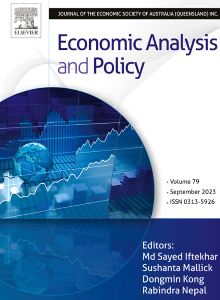气温上升,差距缩小:气候冲击对劳动力市场的意外影响
IF 8.7
2区 经济学
Q1 ECONOMICS
引用次数: 0
摘要
本研究利用中国综合社会调查(CGSS)结合气象数据,考察了气温上升对中国性别工资差距的影响。我们发现,在极端高温时期,男性比女性遭受更大的收入损失,因此发现高温缩小了性别收入差距。此外,我们表明,性别差距的缩小是由男性工人的不成比例的福利损失推动的,而不是女性收入的增加。具体来说,高温显著减少了中国男性主导行业的工作时间。我们还发现,温度超过36°C对男性和女性的收入都有显著的负面影响。异质性分析表明,家庭规模较大、社会经济地位较高、清洁能源依赖程度较低的地区的男女收入差距缩小更为显著。我们的研究结果提供了对气候变化基于性别的经济后果的见解。本文章由计算机程序翻译,如有差异,请以英文原文为准。
Rising temperatures, shrinking gaps: The unexpected labor market impact of climate shocks
This study examines the impact of rising temperatures on the gender pay gap in China using the China General Social Survey (CGSS) combined with meteorological data. We find that men suffer greater income losses than women during periods of extreme heat, thus high temperatures are found to narrow the gender pay gap. Furthermore, we show that this reduction in gender disparity is driven by disproportionate welfare losses among male workers rather than increases in female earnings. Specifically, high temperatures significantly reduce working hours in male-dominated sectors in China. We also find that temperatures exceeding 36 °C have a significant negative effect on incomes for both men and women. The heterogeneity analysis reveals that the narrowing of the gender pay gap is more significant among individuals living in large households, with higher socioeconomic status, and residing in regions with low reliance on clean energy. Our findings offer insights into the gender-based economic consequences of climate change.
求助全文
通过发布文献求助,成功后即可免费获取论文全文。
去求助
来源期刊

Economic Analysis and Policy
ECONOMICS-
CiteScore
9.80
自引率
9.20%
发文量
231
审稿时长
93 days
期刊介绍:
Economic Analysis and Policy (established 1970) publishes articles from all branches of economics with a particular focus on research, theoretical and applied, which has strong policy relevance. The journal also publishes survey articles and empirical replications on key policy issues. Authors are expected to highlight the main insights in a non-technical introduction and in the conclusion.
 求助内容:
求助内容: 应助结果提醒方式:
应助结果提醒方式:


